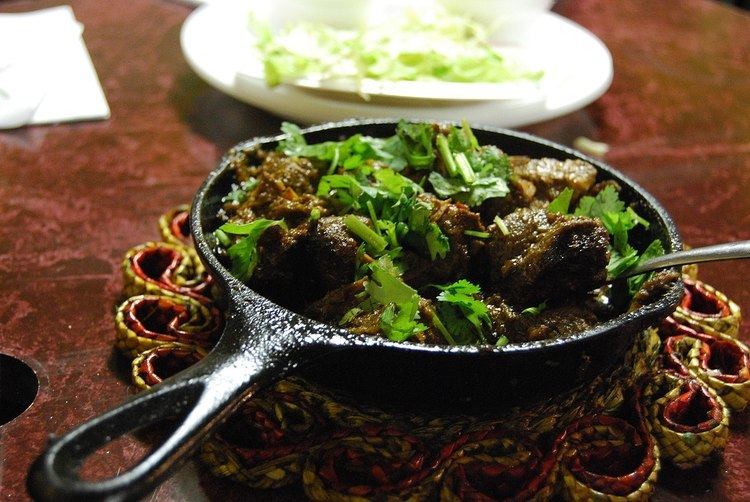 | ||
Sindhi cuisine (Sindhi: سنڌي کاڌا) refers to the native cuisine of the Sindhi people from Sindh, Pakistan. The daily food in most Sindhi households consists of wheat-based flat-bread (phulka) and rice accompanied by two dishes, one gravy and one dry. Today, Sindhi food is eaten in many countries including India, where a sizeable number of Hindu Sindhis migrated following the independence in 1947.
Contents
Historical influences
The arrival of Islam within South Asia influenced the local cuisine to a great degree. Since Muslims are forbidden to eat pork or consume alcohol and the Halal dietary guidelines are strictly observed, Muslim Sindhis focus on ingredients such as beef, lamb, chicken, fish, vegetables and traditional fruit and dairy. Hindu Sindhi cuisine is almost identical with the difference that beef is omitted. The influence of Central Asian, South Asian and Middle Eastern cuisine in Sindhi food is ubiquitous.
Food for special occasions
Certain dishes are served on special occasions such as Diwali a Bahji (vegetable dish) called Chiti-Kuni is made with seven vegetables. Special dishes are also served on recovery from serious illness for example when someone makes a full recovery from Chicken Pox, it is common to make an offering and make "mitho lolo", a sweet griddle-roasted flatbread: the dough is wheat flour mixed with oil (or ghee) and sugar syrup flavored with ground cardamom.
Sindhi Kadhi is a unique and special dish prepared on festive occasions specially by Sindhis residing in India. It consists of a thick spicy gravy made from chick pea flour unlike buttermilk usually used for kadi preparation along with seasonal vegetables. It is served hot with rice.
A popular Sindhi delicacy, is Hilsha fish prepared with numerous cooking methods. It can be deep fried and garnished with local spices, can be cooked with onions and potatoes into a traditional fish meal or barbequed. The fish often has roe, which is called "aani" in Sindhi and is enjoyed as a delicacy. Often fried alongside the palla and served with the fish fillets.
Meals
Beh (simply means 'Lotus root' in English). A high quality lotus root is grown in the North of Sindh which is then cooked in clay-pot using various spices, which then results in an excellent delicacy that is famous all over Pakistan. Sindhi Briyani, Sindhi Curry, Sabu Dal Chawar (yellow daal with rice).
Drinks
Translations
This section provides the translations between Urdu/Hindi, Sindhi and English (British and American) cooking terms of common Sindhi food.
There are occasional differences in Sindhi dialects for instance Hyderabadi Sindhi will refer to an egg as 'bedo' however Sindhis from other parts will refer to it as 'ando'.
Herbs
Spices
Fruit, Vegetable and Pulses
- Aalu Patata (some parts of northern sindh also calls batala) Potato
Nuts
Other
Vegetarian cuisine
Certain sects of the Sindhi community are vegetarians. The Thathai, Halai and Kutchi Bhatias are followers of Vallabh Acharya. He put forward a way to worship Sri Krishna called Pushtimarg. They are strict vegetarians who do not eat even onions and garlic and are devoted to Srinathji, the child form of Sri Krishna.
